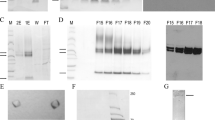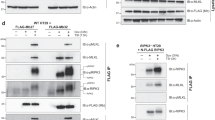Abstract
The receptor tyrosine kinase ErbB-2 plays an important role in cell proliferation and differentiation as well as oncogenesis. We have found that ErbB-2 kinase domain fragmentation is important for the induction of apoptosis. Exogenous expression of peptides derived from the ErbB-2 kinase domain induces cells death with the hallmarks of apoptosis. In contrast, transfection of the ErbB-2 carboxy-terminal domain did not induce apoptosis. We have identified a 37-residue segment from the ErbB-2 kinase N-terminal lobe that can strongly induce apoptosis in transfected cells. Cell death was not blocked by the pan-caspase inhibitor z-VAD-FMK. Similar fragments derived from several other receptor tyrosine kinases also induce cell death. These data imply that proteolytic fragmentation of tyrosine kinases liberates apoptotic fragments that can accelerate cell death.
This is a preview of subscription content, access via your institution
Access options
Subscribe to this journal
Receive 50 print issues and online access
$259.00 per year
only $5.18 per issue
Buy this article
- Purchase on Springer Link
- Instant access to full article PDF
Prices may be subject to local taxes which are calculated during checkout





Similar content being viewed by others
References
Bokoch G . (1998). Cell Death Differ., 5, 637–645.
Bonvin C, Guillon A, van Bemmelen MX, Gerwins P, Johnson GL and Widmann C . (2002). Cell Signal, 14, 123–131.
Bordeaux M, Forcet C, Granger L, Corset V, Billaud M, Bredesen D, Edery P and Mehlen P . (2000). EMBO J., 19, 4056–4063.
Charette S, Lambert H and Landry J . (2001). J. Biol. Chem., 276, 36071–36074.
Chen Y, Meyer C, Ahmed B, Yao Z and Tan T . (1999). Oncogene, 18, 7370–7377.
Cuello M, Ettenberg S, Clark A, Keane M, Posner R, Nau M, Dennis P and Lipkowitz S . (2001). Cancer Res., 61, 4892–4900.
Endo K, Oki E, Biedermann V, Kojima H, Yoshida K, Johannes F, Kufe D and Datta R . (2000). J. Biol. Chem., 275, 18476–18481.
Ghayur T, Hugunin M, Talahian R, Ratnofsky S, Quinlan C, Emoto Y, Pandley P, Datta R, Huang Y, Kharbanda S, Allen H, Kamen R, Wong W and Kufe D . (1996). J. Exp. Med., 184, 2399–2404.
Inbal B, Shani G, Cohen O, Kissil J and Kimchi A . (2000). Mol. Cell. Biol., 20, 1044–1054.
Kim J, Choi E and Joe C . (2000). Oncogene, 19, 4491–4499.
Kogel D, Bierman H, Preuss U and Scheidtmann K . (1999). Oncogene, 18, 7212–7218.
Lin Y, Devin A, Cook A, Keane M, Kelliher M, Lipkowitz S and Liu Z . (2000). Mol. Cell. Biol., 20, 6638–6645.
Münster P, Srethapakdi M, Moasser M and Rosen N . (2002). Cancer Res., 61, 2945–2952.
Neve R, Lane H and Hynes N . (2001). Ann. Oncol., 12, S9–S13.
Rudel T and Bokoch G . (1997). Science, 276, 1571–1574.
Sabourin L, Seale P, Wagner J and Rudnicki M . (2000). Mol. Cell. Biol., 20, 684–696.
Sebbagh M, Renvoize C, Hamelin J, Riche N, Bertoglio J and Breard J . (2001). Nat. Cell Biol., 3, 346–352.
Smith V, Hobbs S, Court W, Eccles S, Workman P and Kelland LR . (2002). Anticancer Res., 22, 1993–1999.
Sun X, Lee J, Navas T, Baldwin D, Stewart T and Dixit V . (1999). J. Biol. Chem., 274, 16871–16875.
Takahashi M, Mukai H, Toshimori M, Miyamoto M and Ono Y . (1998). Proc. Natl. Acad. Sci. USA, 95, 11566–11571.
Tikhomirov O and Carpenter G . (2000). J. Biol. Chem., 275, 26625–26631.
Tikhomirov O and Carpenter G . (2001). J. Biol. Chem., 276, 33675–33680.
Tikhomirov O and Carpenter G . (2003). Cancer Res., 63, 39–43.
Ura S, Masuyama N, Graves J and Gotoh Y . (2001). Proc. Natl. Acad. Sci. USA, 98, 10141–10153.
Wu Y, Huang C-L, Kung H and Huang C-Y . (2001). J. Biol. Chem., 276, 17672–17678.
Xu W, Mimnaugh E, Rosser M, Nicchitta C, Marcu M, Yarden Y and Neckers L . (2001). J. Biol. Chem., 276, 3702–3708.
Yarden Y and Sliwkowski M . (2001). Nat. Rev. Mol. Cell Biol., 2, 127–137.
Acknowledgements
We are grateful to Catherine Alford and Vanderbilt University Flow Cytometry Core Facility for technical support. The support of the Department of Defense Idea Award Grant DAMD 17-00-1-0483, grant of the Vanderbilt Ingram Cancer Center P30 CA68485 and the Vanderbilt Diabetes Center P30 DK20593 for core facility support are acknowledged.
Author information
Authors and Affiliations
Corresponding author
Rights and permissions
About this article
Cite this article
Tikhomirov, O., Dikov, M. & Carpenter, G. Identification of proteolytic fragments from ErbB-2 that induce apoptosis. Oncogene 24, 3906–3913 (2005). https://doi.org/10.1038/sj.onc.1208534
Received:
Revised:
Accepted:
Published:
Issue Date:
DOI: https://doi.org/10.1038/sj.onc.1208534
Keywords
This article is cited by
-
A dominant-negative N-terminal fragment of HER2 frequently expressed in breast cancers
Oncogene (2013)
-
Dependence receptors: a new paradigm in cell signaling and cancer therapy
Oncogene (2010)
-
A multi-factor model for caspase degradome prediction
BMC Genomics (2009)
-
Proteolytic cleavages give receptor tyrosine kinases the gift of ubiquity
Oncogene (2009)
-
The shadow of death on the MET tyrosine kinase receptor
Cell Death & Differentiation (2008)



